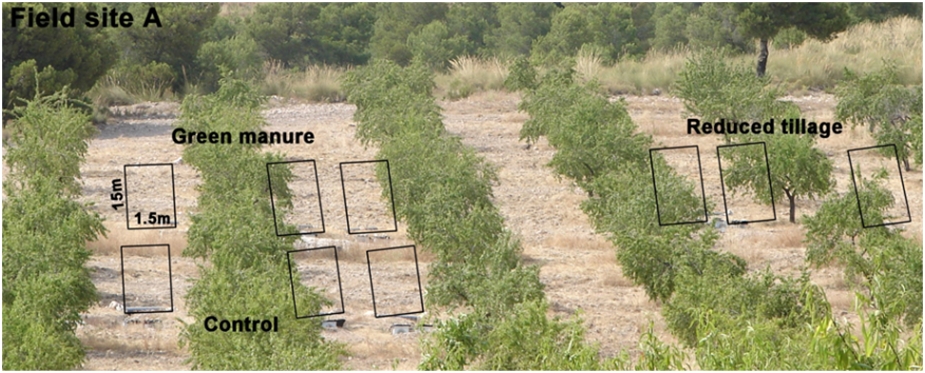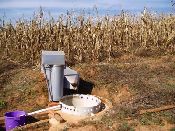|
In the Guadalentín basin in south-eastern Spain, land degradation is considered severe due to a combination of several factors. The semi-arid climate has dry summers followed by intense autumn rainfall, while there is a steep topography and fragile soils. Desertification takes the form of soil erosion and drought. Moreover, considerable land use changes have taken place over the last centuries, which is an important driving force for further degradation in the area. Reduced tillage may improve the soil structure, improve infiltration and reduce runoff and erosion. Green manure will provide a better soil cover and additional nutrients when the vegetation matter is ploughed into the soil.
Experiments combining green manure and minimum tillage
|
Experiments were carried out in an almond field without terraces where reduced tillage and green manure technologies were applied. The location was in the Torrealvilla catchment, Murcia, Spain. For green manure a mixture of barley and vetch (Vicia sativa) was sown in autumn and ploughed into the soil in spring. Ploughing was done only twice in a year in both the green manure field and the reduced tillage field, whereas the field under conventional tillage was ploughed between 3-5 times per year, a practice commonly followed in the study area.
To monitor the effect of the treatments on ecological criteria, three replica open runoff erosion plots (Gerlach type) were installed in each treatment, giving a total of 9 runoff plots (Figure below). To determine the exact contributing areas to the open runoff plots, a terrestrial laser scanner (TLS) was used to construct a high resolution digital elevation model. Furthermore, soil moisture of the upper 20 cm was measured about every month at 30 random points in each field with FDR equipment.
After every event, runoff and soil loss were measured by collecting the water and sediments from the Gerlach runoff plots and storage tanks. The experiment started in autumn 2008. Data on soil moisture, runoff and erosion was collected until 2011. In addition amount of applied green manure seed and almond crop harvest data was also collected.

 |
The results show that green manure reduces surface runoff whereas the soil loss amount is the lowest in reduced tillage (see figure below). These results also show that erosion under reduced tillage and green manure treatment was reduced on average by about 60% as compared to a conventional tillage regime.
|
Monitoring of soil moisture did not show consistent differences between the different treatments. Differences were very small, while in general soil moisture tended to be even higher under reduced tillage and green manure treatment than under control conditions, possibly due to the effect of dew formation on plants below the almond trees.
Reduced tillage reduces production costs as compared to conventional cultivation practices but it does not increase the yield.
| The results are evaluated from a production, socio-cultural and economic point of view. The bars express the estimated or measured percentage of change with respect to the reference situation. This change can be positive (blue) or negative (red). Note that this evaluation is based on the experiments, on the long term experience of the coordinating team in this area and on consultations with the farmers. |
 |
- Low operation cost due to reduced tillage and with high quality ecological product is interesting for the farmers but there should be better marketing of eco-almonds and olives.
- Green manure is effective and feasible although it doesn’t give a direct economic benefit so the acceptance is not yet very high. More information should be given about this.
|
Reduced tillage reduced soil and water loss, but yield was not increased, at least not after 2 years of monitoring. Nevertheless, operation costs are lower, so if the yield is maintained at least at the same level there is an economic benefit compared to conventional treatment. These results also show that erosion under reduced tillage and green manure treatment was reduced on average by about 60% as compared to a conventional tillage regime.
|
|
Green manuring proved to be effective and feasible in reducing soil and water loss while increasing almond production. Since operation costs do not significantly increase, the profit is also higher than under conventional production.
|
|







